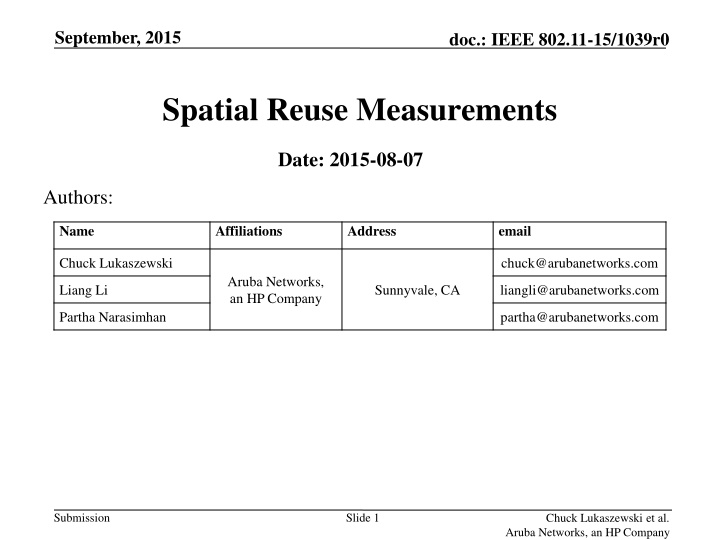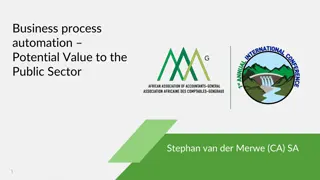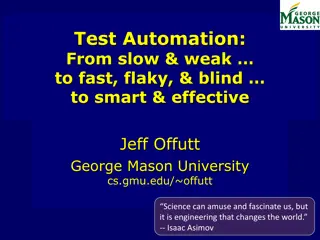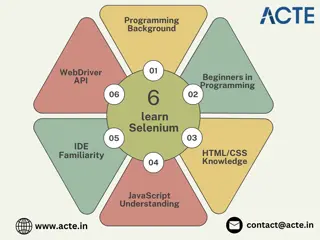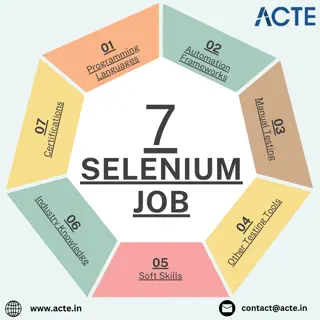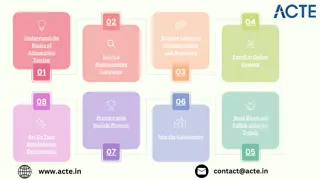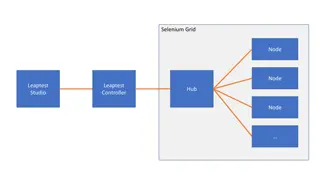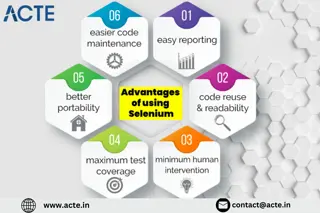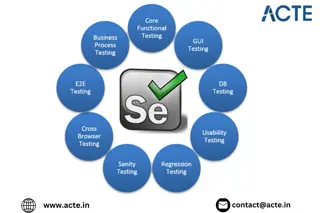Introduction to Test Automation with Selenium
Selenium is a powerful tool for automating web applications primarily used for testing purposes. It can also automate boring administration tasks and is supported by major browser vendors. Selenium includes Selenium IDE for recording user interactions, Selenium 1.0 with Remote Control for browser automation, and Selenium Grid for scaling tests. Selenium 2.0 introduces WebDriver API for a simpler programming interface and better support for dynamic web pages.
Download Presentation

Please find below an Image/Link to download the presentation.
The content on the website is provided AS IS for your information and personal use only. It may not be sold, licensed, or shared on other websites without obtaining consent from the author.If you encounter any issues during the download, it is possible that the publisher has removed the file from their server.
You are allowed to download the files provided on this website for personal or commercial use, subject to the condition that they are used lawfully. All files are the property of their respective owners.
The content on the website is provided AS IS for your information and personal use only. It may not be sold, licensed, or shared on other websites without obtaining consent from the author.
E N D
Presentation Transcript
September, 2015 doc.: IEEE 802.11-15/1039r0 Spatial Reuse Measurements Date:2015-08-07 Authors: Name Affiliations Address email Chuck Lukaszewski chuck@arubanetworks.com Aruba Networks, an HP Company Liang Li Sunnyvale, CA liangli@arubanetworks.com Partha Narasimhan partha@arubanetworks.com Submission Slide 1 Chuck Lukaszewski et al. Aruba Networks, an HP Company
September, 2015 doc.: IEEE 802.11-15/1039r0 Abstract The SR ad hoc has defined a calibration scenario in [1], and nine companies have presented initial findings in [2] & [3]. This contribution adds empirical, open air measurements using modified ED & preamble detect (PD) thresholds. We find that spatial reuse using manually fixed PD controls on AP and STA is real for very short AP-STA distances (3 meters) Results for 2 concurrent BSS are provided at four different inter-BSS distances, for both 2 STA and 6 STA cases Results for 3 concurrent BSS are provided, for 2 STA case When taken together with simulation results, TGax should pursue development of SR techniques. Submission Slide 2 Chuck Lukaszewski et al. Aruba Networks, an HP Company
September, 2015 doc.: IEEE 802.11-15/1039r0 40m Linear Reuse Testbed 3m S5-B S5-A BSS5 Based on 15/0652r1 5 BSS Each BSS has 3 nodes: (1) 802.11ac 3SS AP (2) 802.11ac 2SS laptop 10m inter-BSS distance 3m STA AP distance 1m inter-STA distance Manual fixing of ED/PD thresholds on all nodes 30m 3m S4-B A4 S4-A BSS4 20m 3m S3-B A3 S3-A BSS3 10m 3m S2-B A2 S2-A BSS2 0m 3m S1-B A1 S1-A Submission Slide 3 Chuck Lukaszewski et al. Aruba Networks, an HP Company BSS1
September, 2015 doc.: IEEE 802.11-15/1039r0 Reference Deployment Scenario in 15/0652r1 STA1 STA3 3m 3m 30m AP1 AP2 STA4 STA2 Submission Slide 4 Chuck Lukaszewski et al. Aruba Networks, an HP Company
September, 2015 doc.: IEEE 802.11-15/1039r0 Key Differences from Calibration Scenario Testing in this contribution differs from 15/0652r1 in the following ways: VHT20 (vs. VHT80) AP EIRP = 15 dBm (vs. 20) / STA EIRP = 15 dBm (vs. 13) Floating data MCS (vs. fixed MCS5) Up to 64 MPDUs per A-MPDU (vs. 32) Bidirectional (vs. UL only) SGI enabled Beacons enabled RTS/CTS enabled PD thresholds -85 / -75 / -65 / -55 (vs. -76 / -66 / -56) Submission Slide 5 Chuck Lukaszewski et al. Aruba Networks, an HP Company
September, 2015 doc.: IEEE 802.11-15/1039r0 Lab Building Floor Plan with AP/STA Locations BSS5 BSS4 BSS3 BSS2 BSS1 Submission Slide 6 Chuck Lukaszewski et al. Aruba Networks, an HP Company
September, 2015 doc.: IEEE 802.11-15/1039r0 Viewing BSS2 BSS5 from BSS1 STA5 AP2 STA4 STA3 AP3 STA2 AP4 3m AP5 Submission Slide 7 Chuck Lukaszewski et al. Aruba Networks, an HP Company
September, 2015 doc.: IEEE 802.11-15/1039r0 Testbed Configuration BSS & RF: Channel Modulation STA EIRP AP EIRP Control Rate 120 VHT20** 15 dBm 15 dBm 6 Mbps ** 15/0652r1 calls for VHT80. VHT20 used in this contribution. Test Automation: Traffic generation platform Traffic type Traffic direction Send data rate (per STA) Number of data flows IxChariot 8.1 UDP (payload 1460 bytes) DL and UL Unlimited (DL), 75 per STA Mbps(UL) 2 data flows, Unlimited send rate (DL) 5 data flows, 15 Mbps per flow (UL) 1 Gbps Link between each STA and Wired Endpoint Submission Slide 8 Chuck Lukaszewski et al. Aruba Networks, an HP Company
September, 2015 doc.: IEEE 802.11-15/1039r0 Inter-BSS RSSI Calibration Submission Slide 9 Chuck Lukaszewski et al. Aruba Networks, an HP Company
September, 2015 doc.: IEEE 802.11-15/1039r0 Intra-BSS RSSI Calibration (Typical) AP AP STA A STA B AP -37 dBm -39 dBm STA A -47 dBm -35 dBm 3m 3m STA B -44 dBm -38 dBm 1m Station A Station B Submission Slide 10 Chuck Lukaszewski et al. Aruba Networks, an HP Company
September, 2015 doc.: IEEE 802.11-15/1039r0 Single BSS Calibration PD= -85 / ED = -62 (UDP Goodput & MCS Distribution) Submission Slide 11 Chuck Lukaszewski et al. Aruba Networks, an HP Company
September, 2015 doc.: IEEE 802.11-15/1039r0 2 BSS / 2 STA Goodput (VHT20) D = 10m/20m/30m/40m PD = -55 / -65 / -75 / -85 Submission Slide 12 Chuck Lukaszewski et al. Aruba Networks, an HP Company
September, 2015 doc.: IEEE 802.11-15/1039r0 2 BSS / 2 STA Goodput (Downstream VHT20) D = 10m/20m/30m/40m PD = -55 / -65 / -75 / -85 Submission Slide 13 Chuck Lukaszewski et al. Aruba Networks, an HP Company
September, 2015 doc.: IEEE 802.11-15/1039r0 2 BSS / 2 STA Goodput (Upstream VHT20) D = 10m/20m/30m/40m PD = -55 / -65 / -75 / -85 Submission Slide 14 Chuck Lukaszewski et al. Aruba Networks, an HP Company
September, 2015 doc.: IEEE 802.11-15/1039r0 40m Linear Reuse Testbed 3m S5-B S5-A BSS5 Based on 15/0652r1 5 BSS Each BSS has 3 nodes: (1) 802.11ac 3SS AP (2) 802.11ac 2SS laptop 10m inter-BSS distance 3m STA AP distance 1m inter-STA distance Manual fixing of ED/PD thresholds on all nodes 30m 3m S4-B A4 S4-A BSS4 20m 3m S3-B A3 S3-A BSS3 10m 3m S2-B A2 S2-A BSS2 0m 3m S1-B A1 S1-A Submission Slide 15 Chuck Lukaszewski et al. Aruba Networks, an HP Company BSS1
September, 2015 doc.: IEEE 802.11-15/1039r0 2 BSS / 6 STA Tests Increase STA counts in each BSS from 2 STAs to 6 STAs Repeat sweep of PD/ED settings at 10m / 20m / 30m / 40m Characterize per-STA fairness in up & down directions Submission Slide 16 Chuck Lukaszewski et al. Aruba Networks, an HP Company
September, 2015 doc.: IEEE 802.11-15/1039r0 2 BSS / 6 STA Goodput (Downstream VHT20) D = 10m/20m/30m/40m PD = -55 / -65 / -75 / -85 Submission Slide 17 Chuck Lukaszewski et al. Aruba Networks, an HP Company
September, 2015 doc.: IEEE 802.11-15/1039r0 2 BSS / 6 STA Fairness (Downstream VHT20) D = 10m/20m/30m/40m PD = -55 / -65 / -75 / -85 Submission Slide 18 Chuck Lukaszewski et al. Aruba Networks, an HP Company
September, 2015 doc.: IEEE 802.11-15/1039r0 2 BSS / 6 STA Goodput (Upstream VHT20) D = 10m/20m/30m/40m PD = -55 / -65 / -75 / -85 Submission Slide 19 Chuck Lukaszewski et al. Aruba Networks, an HP Company
September, 2015 doc.: IEEE 802.11-15/1039r0 2 BSS / 6 STA Fairness (Upstream VHT20) D = 10m/20m/30m/40m PD = -55 / -65 / -75 / -85 Submission Slide 20 Chuck Lukaszewski et al. Aruba Networks, an HP Company
September, 2015 doc.: IEEE 802.11-15/1039r0 Test Design 3 BSS / 2 STA BSS4 BSS7 BSS6 Submission Slide 21 Chuck Lukaszewski et al. Aruba Networks, an HP Company
September, 2015 doc.: IEEE 802.11-15/1039r0 Results: 3 BSS / 2 STA (Down) Submission Slide 22 Chuck Lukaszewski et al. Aruba Networks, an HP Company
September, 2015 doc.: IEEE 802.11-15/1039r0 Results: 3 BSS / 2 STA (Up) TBD Submission Slide 23 Chuck Lukaszewski et al. Aruba Networks, an HP Company
September, 2015 doc.: IEEE 802.11-15/1039r0 Conclusions Spatial reuse via PD threshold tuning is real. Improvement scales with BSS count, but linearity depends on many factors including inter-BSS distance, intra-BSS distance and supportable MCS. Per-STA and Per-BSS fairness appears to be generally good in presence of OBSS noise. Minimum viable SR distance is ~30m in free space. Diminishing or no return at smaller distances Possibly due to SINR compression reducing maximum supportable MCS rate Should the calibration scenario be increased to sweep longer distances? Submission Slide 24 Chuck Lukaszewski et al. Aruba Networks, an HP Company
March, 2015 doc.: IEEE 802.11-15/1039r0 References [1] 15/0652r1 Reference Simulation Model for Dynamic CCA / DSC Calibration , M Mori, Y Morioka et al (Sony, SR, Nokia, MediaTek, Broadcom), May 2015 [2] 15/0801r0 - DCCA/DSC Reference Simulation Results , M Mori, Y Morioka et al (Sony, WILUS, NTT, SR, Broadcom, LG, MediaTek), July 2015 [3] 15/886r0 - DSC Calibration Result , C Yu, F Hsu et al (MediaTek), July 2015 Submission Slide 25 Chuck Lukaszewski et al. Aruba Networks, an HP Company
